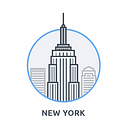Putting Together iOS Designs (Because These Can Change..Infinitely!)
I am designing wallpapers, the backgrounds of iOS Phone designs..
I started with icons..
But now I am designing wallpapers.
This is a wallpaper. In the mobile design, it has a thin sheet overlayed on top of it.
This is what the overlay looks like. It creates a glossy effect over the screen.
This bottom navigation is called a “dock”, and contains different icons which are grouped into one folder in Sketch. This is good way to keep stuff organized. This transparent dock background with it’s snow-white color and faded opacity is another overlay that works to highlight the icons which are navigable.
Here we see yet another screen and how the background with the wallpaper, dock and icons are covered with another overlay. This overlay is a sheet that covers the mobile screen, and has a background blur of 10% with a overlay of also 10%, subtle design strategies which go far to give the user the effect that they are using the weather application.
Layering is a design strategy that Apple Designers and mobile designers are using nowadays to show emphasis on interaction. After all it is about being able to easily flit through different applications without really having to think, and using overlays gives us this capability.
Employing these type of design strategies are not really that difficult. It is easy to come up with great mobile designs but it would be even more helpful and cost-effective to do user research first, instead of just jumping into a wayward and overwhelming project; after all we want to pinpoint user needs, frustrations and desires. After all, UX is not UX without users, and UI is just an implementation which comes after establishing the UX.
Continuing, I am designing widgets, and switches.
Switches!?! This sounds scary.
Let’s look at the human interface design guidelines set out by Apple.
It’s always good to follow documentation instead of just barging ahead and having to redo stuff because :-( yeah that sucks!

